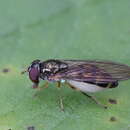Associations
provided by BioImages, the virtual fieldguide, UK
In Great Britain and/or Ireland:
Animal / pathogen
Entomophthora muscae infects dead adult of Melanostoma scalare
Other: major host/prey
Fungus / feeder
adult of Melanostoma scalare feeds on nectar of Sphacelia anamorph of Claviceps
Melanostoma scalare: Brief Summary
provided by wikipedia EN
Melanostoma scalare, the chequered hoverfly, is a very common species of hoverfly.
- license
- cc-by-sa-3.0
- copyright
- Wikipedia authors and editors
Description
provided by Zookeys
Head: Colour bluish black. Angle of approximation of eyes 80°–90°. Eye contiguity about as long as length of frontal triangle. Ocellar triangle slightly longer than wide with dark and pale pile and with thin grey dusting. Occiput very narrow and with pale pile. Frontal triangle with dense grey or yellowish grey dusting except area above lunule with thin dusting. Lateral parts of frontal triangle with pale pile. Face with dense grey or yellowish grey dusting except shiny facial tubercle. Lateral parts of face with pale pile. Gena about as wide as basoflagellomere and with dense greyish dusting. Antenna mainly yellow, anterodorsal margin of basoflagellomere distinctly brown. Basoflagellomere about 1.5 times as long as wide. Arista yellowish brown and about twice as long as length of basoflagellomere. Arista short pubescent with pile about as long as width of base of arista (Fig. 4A).
Thorax: Scutum shining bluish black except for thin greyish dusting at anterior margin. Scutum with pale yellow erect pile and with shorter pale semi-adpressed pile on anterior margin. Anterior part of scutum with long erect pale pile which length at most third of length of scutellum. Postpronotum totally covered with dense greyish dusting. Notopleuron covered with greyish dusting. Scutellum shining bluish black with pale erect pile at its dorsum, hind margin and ventral side. Pleura bluish black with grey or yellowish grey dusting. Pleura with pale erect pile. Calypter whitish yellow with whitish pile at edge. Halter yellow with slightly darkened base of stem.
Wing: Microtrichose except for cell BM basally narrowly bare, with indistinct brownish ting. Stigma pale yellowish brown.
Legs: Coxa black with grey dusting. Trochanter yellowish brown. Femur and tibia yellow and brown in varying extent. Tarsus yellowish brown. Metaleg usually darker than other leg. Leg with all pile pale.
Abdomen: Terga dark brown or black with weak greyish dusting. Tergum 2 with yellow long oval maculae. Terga 3 and 4 with a pair of long yellow subrectangular maculae. Terga 1 and 2 laterally with long pale pile. Terga with dark and pale semi-adpressed pile. Pale pile on yellow maculae. Terga 2, 3 and 4 each about twice as long as wide. Sterna with weak dusting and with pale semi-adpressed pile. Sternum 2 about 2.5 times as long as its width at its posterior margin. Sternum 3 about twice as long as its width at its anterior margin. Sternum 4 nearly twice as long as its width at its anterior margin. Shape of sterna 2–4 are shown in Fig. 5A.
Male genitalia: Cercus and surstylus (Fig. 6A). Postgonite long and without distinct ridges laterally (Figs 7A, 8A). Postgonite ventrally in Fig. 9A. The hypandrial margin at postgonites with short triangular projections, index DL about 1.5 (Figs 10A, 11A).
Similar to male, but differs as follows:
Head: Frons shining except greyish dusted triangles which narrowly connected to dusted area of face. Frons at level of front ocellus about as broad as length of antenna. Occiput as broad as two diameters of an ocellus.
Thorax: Scutum with short pale pile.
Abdomen: Tergum 2 with pair of yellow oval maculae. Terga 3 and 4 with a pair of yellow elongated triangular maculae. Tergum 5 at anterior margin with a pair of short yellow maculae. Tergum 2 about 0.6 times as long as its width at its posterior margin. Tergum 3 about 0.7 times as long as its width at its posterior margin. Tergum 4 about 0.9 times as long as its width at its posterior margin. Sternum 2 about 0.8 times as long as its width at its posterior margin. Sternum 3 about 0.8 times as long as its width at its anterior margin. Sternum 4 about 0.9 times as long as its width at its anterior margin. Shape of sterna 2-4 are shown in Fig. 12A.
- license
- cc-by-3.0
- copyright
- Antti Haarto, Gunilla Ståhls
- bibliographic citation
- Haarto A, Ståhls G (2014) When mtDNA COI is misleading: congruent signal of ITS2 molecular marker and morphology for North European Melanostoma Schiner, 1860 (Diptera, Syrphidae) ZooKeys 431: 93–134
- author
- Antti Haarto
- author
- Gunilla Ståhls
Distribution
provided by Zookeys
A very common and abundant species, known from the whole Palaearctic area and Northern Africa.
- license
- cc-by-3.0
- copyright
- Antti Haarto, Gunilla Ståhls
- bibliographic citation
- Haarto A, Ståhls G (2014) When mtDNA COI is misleading: congruent signal of ITS2 molecular marker and morphology for North European Melanostoma Schiner, 1860 (Diptera, Syrphidae) ZooKeys 431: 93–134
- author
- Antti Haarto
- author
- Gunilla Ståhls

